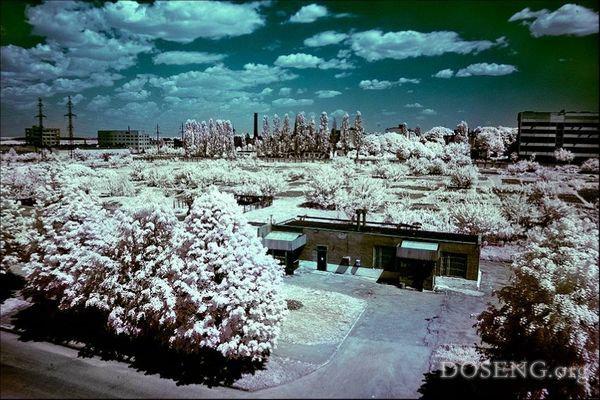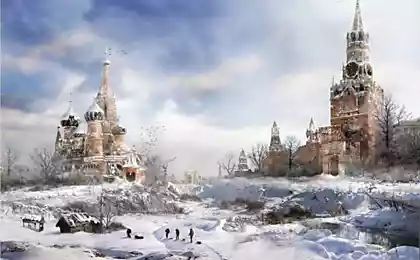1122
Nuclear winter

"The first angel sounded: And hail and fire mingled with blood, and they were thrown to the ground; and a third of the earth was burnt up, and a third of the trees was burnt up, and all green grass was burnt ».
Revelation, ch. 8
Throughout the world, after the tragedies of Hiroshima and Nagasaki began to study the consequences of a possible nuclear war - the destruction of the most powerful explosions, the spread of radiation, biological destruction. In the 80 years we were undertaken studies on climate effects and, now known as the "nuclear winter».
Fireball nuclear explosion burns or chars objects at a significant distance from the epicenter. About 1/3 of the energy of the explosion, which occurred at low altitude, stands out as an intense light pulse. So, 10 km from the epicenter capacity of 1 Mt of light flash in the first seconds is thousands of times brighter than the sun. During that time, light paper, cloth or other flammable materials. Man receives third-degree burns. The resulting pockets of flame (primary fire) partially blanked powerful air blast wave, but the flying sparks, burning debris, splashes of burning oil, short circuit in the electrical cause extensive secondary fires, which can last for many days.
When multiple independent fires combined into one powerful center, formed "firestorm" that can destroy a great city (as in Dresden and Hamburg at the end of the Second World War). Intense heat in the center of this "tornado" picks up the huge mass of air, creating storms on the surface of the earth, which serves all the new portions of oxygen to the fire. "Smerch" rises to the stratosphere smoke, dust and soot, which form a cloud, virtually closing the sunlight coming "nuclear night" and, as a consequence, "nuclear winter».
Calculations of the amount of aerosol produced after these fires are made on the basis of the average value of 4 g of flammable material on the surface of 1 cm 2, although in cities such as New York or London, its value reaches 40 g / cm2. By the most conservative estimates, a nuclear conflict (according to the average, so-called "baseline" scenario) produced about 200 million tons of aerosol, 30% of which is strongly absorbed by sunshine carbon. As a result, the area between 30 ° and 60 ° with. w. will be deprived of sunlight for a few weeks.
Huge fires emit into the atmosphere a huge amount of aerosol and cause "nuclear night" until the 80s were not considered by scientists to assess the consequences of nuclear explosions. For the first time the paramount importance of massive fires for the subsequent cascade of irreversible global climate and environmental changes have in 1982 a German scientist Paul Crutzen.
Why scientists do not notice the "nuclear winter" in the 40-70-ies, and whether now our knowledge of the effects of nuclear war conclusive?
The fact that conduct nuclear tests still were isolated, single bursts, while the most "soft" (100 Mt) scenario of a nuclear conflict, accompanied by a "nuclear night", provides a blow to many major cities. In addition, tests were banned now so that it does not cause large fires. The new estimates have demanded cooperation and understanding of specialists in various fields of science: climate scientists, physicists, mathematicians, biologists. Only with such a complex interdisciplinary approach, is gaining momentum in recent years, it was able to understand the whole set of interrelated phenomena that seemed previously disparate facts. It is interesting that the "nuclear winter" refers to global problems, to explore which scientists only recently have learned.
Study and modeling of global problems started on the initiative and under the direction of NN Mosaic in the CCAS in the 70-ies. The study was based on the idea that people - part of the biosphere, and its existence is unthinkable biosphere. Our civilization can survive only in a narrow range of parameters of the biosphere. The growing power of the human impact on the environment highlights the choice of strategy of social development, guaranteeing not only the existence but also the co-evolution (co-evolution) of humanity and the environment.
Of the currently known models of varying complexity to calculate the climate change as a result of a thermonuclear conflict is one of the most advanced three-dimensional hydrodynamic model of the CCAS. The first calculations performed on this model VV Alexandrov and colleagues under the direction of NN Moses gives the geographical distribution of meteorological characteristics depending on the time elapsed since the nuclear conflict that makes the simulation results are extremely visual, really feel. Similar results on the agreed scenario of a nuclear war at the same time received the American scientists. In further work to assess the effects associated with the spread of aerosols, we investigated the dependence of the characteristics of "nuclear winter" of the initial distribution of fires and lift particulate cloud. The calculations for the two "extreme scenarios", taken from the works of K. Sagan: "hard" (total capacity of 10,000 Mt of explosions) and "soft" (100 Mt).

In the first case about 75% of the total capacity of nuclear powers. This so-called general nuclear war, primary, immediate effects of which are characterized by the huge scale of death and destruction. In the second scenario, "spent" less than 1% of the world's existing nuclear arsenal. However, and this is 8200 "Hiroshima" ("hard" version - almost a million)!
Soot, smoke and dust in the atmosphere over the regions of the northern hemisphere, have been subject to attacks, because of the global atmospheric circulation spread to large areas, 2 weeks covering the entire Northern Hemisphere and the Southern part (Figure 1). Significantly, how long soot and dust will be in the atmosphere and create an opaque veil. Aerosol particles will settle to the ground by the force of gravity and washed out by rain. Duration of sedimentation depends on particle size and the height at which they find themselves. Calculations using the above model showed that aerosols in the atmosphere will continue for much longer than previously thought. The fact that the carbon black to sunlight, will go up along with the heated air masses and it will come out of the education of precipitation (Figure 2). Ground will be colder than the air located above and convection (including evaporation and precipitation, the so-called water cycle) greatly weakens, rainfall becomes less, so that the spray will be washed away much slower than under normal conditions. All this will lead to the fact that the "nuclear winter" will be tightened (Figure 3, 4).
So, the main climatic effects of nuclear war, regardless of the scenario, will be a "nuclear winter" - sudden, severe (from 15 ° to 40 ° C in different regions) and the duration of cooling air over the continents. Particularly severe consequences would have been in the summer, when over land in the Northern Hemisphere temperature falls below the freezing point of water. In other words, all living things that do not burn in the fires, vymerznet.
"Nuclear winter" would entail an avalanche of destructive effects. This is especially sharp temperature contrasts between land and the ocean, as the latter has great thermal inertia, and the air above it cools much weaker. On the other hand, as noted above, changes in the atmosphere suppress convection and over submerged in the night, handcuffed cold continents break out severe droughts. Where the events have occurred in the summer, after approximately 2 weeks, as indicated above, the temperature at the land surface in the Northern Hemisphere falls below zero, and sunlight hardly becomes. Plants do not have time to adapt to the low temperatures and die. If a nuclear war started in July, in the Northern Hemisphere would have died all the vegetation and in the South - in part (Fig. 5). In the tropics and subtropics, she would have died almost instantly, because rainforests can exist only in a narrow range of temperature and illumination.
Many animals in the northern hemisphere and will not survive because of a lack of food and the complexity of its search in the "nuclear winter". In the tropics and subtropics will be an important factor in the cold. Die many kinds of mammals, all birds; reptiles can survive.
If the events described took place in the winter, when the plants of northern and midland "asleep", their fate in the "nuclear winter" will determine the frost. For each plot of land with a known ratio of tree species by comparing the temperature in the winter and during the "nuclear winter", as well as data on the destruction of trees in the ordinary and anomalous winter with prolonged frost is possible to estimate the mortality rate of trees in the "nuclear winter" (Fig. 6 ).
The resulting huge areas of forest will be dead material for secondary fires. Decomposition of dead organic matter result in the release into the atmosphere of large amounts of carbon dioxide, disrupt global carbon cycle. Destruction of vegetation (especially in the tropics) causes the active erosion.
"Nuclear Winter" will undoubtedly cause almost total destruction of the presently existing ecosystems, particularly agro-ecosystems, so important for the maintenance of human life. Vymerznut all fruit trees, vineyards and t. N. All livestock will die, because the infrastructure would be destroyed livestock. Vegetation can partly recover (saved seeds), but the process will be slowed down by other factors. "Radiation shock" (a sharp rise in the level of ionizing radiation to 500-1000 rad) destroy most mammals and birds and cause serious radiation damage to conifers. Huge fires destroyed most of the forests, steppes, agricultural land. During nuclear explosions occur venting large amounts of nitrogen oxides and sulfur. They will fall to the ground as harmful to all living things "acid rain».
Any of these factors is extremely damaging to the ecosystem. But the worst thing is that after a nuclear conflict, they will act synergistically (ie. E. Not just together at the same time as enhancing the effect of each).
The question of the validity and accuracy of the results from a scientific point of view, extremely important. However, the "critical point" after which begin irreversible catastrophic changes in the biosphere and the Earth's climate is already defined "nuclear threshold", as noted, it is very low - about 100 Mt.
No missile defense system can not be 100% impervious. Meanwhile, for the irreparable trouble enough, and 1% (1% of the existing nuclear arsenal - about 100 ballistic missile warheads at an aggregate capacity equal to 5000 "Hiroshima»).
The phenomenon of "nuclear winter" has been extensively studied by the international scientific community. In 1985, the Scientific Committee for the Study of the protection of the Environment (SCOPE) issued a prepared team of authors from a number of two-volume edition devoted to estimates of climatic and environmental consequences of nuclear war.
"Calculations show - it said - that the dust and smoke spread to most of the tropics and the Southern Hemisphere. Thus, even non-belligerent countries, including those far away from the conflict area, will experience its devastating effects. India, Brazil, Nigeria or Indonesia can be destroyed by nuclear war, despite the fact that their territories are not burst, no warhead ... "Nuclear winter" means a significant increase in the scale of the suffering of humanity, including the nation and regions not involved directly in nuclear war ... A nuclear war would cause the destruction of life on Earth, the catastrophe, unprecedented in human history, and will be a threat to the very existence of mankind ».
Fig. 1. Distribution of the smoke and dust in the atmosphere above the surface in the first 30 days after the nuclear war ("0 days" - the initial localization of emissions in Eastern Europe).
Fig. 2. The meridian section of the atmosphere. Showing the distribution of smoke for 15-20 hours and the area of formation of precipitation.
Fig. 3, 4. Change the air temperature at the surface of the Earth in a month after a dispute with "hard" (the power of explosions - 10,000 MT) and "soft" (100 Mt) scenarios.
Fig. 5. The defeat of the plant in the "nuclear winter" in the July 1 - the death of 100% 2 - 50% 3 - no deaths.
Fig. 6. infected plants in the "nuclear winter" in the January 1 - 100% 2 - 90% 3 - 75%, 4 - 50% 5 - 25%, 6 - 10%, 7 - no deaths.
References:
The magazine "Ecology and Life". Article V. Parkhomenko, AM Tarko.























